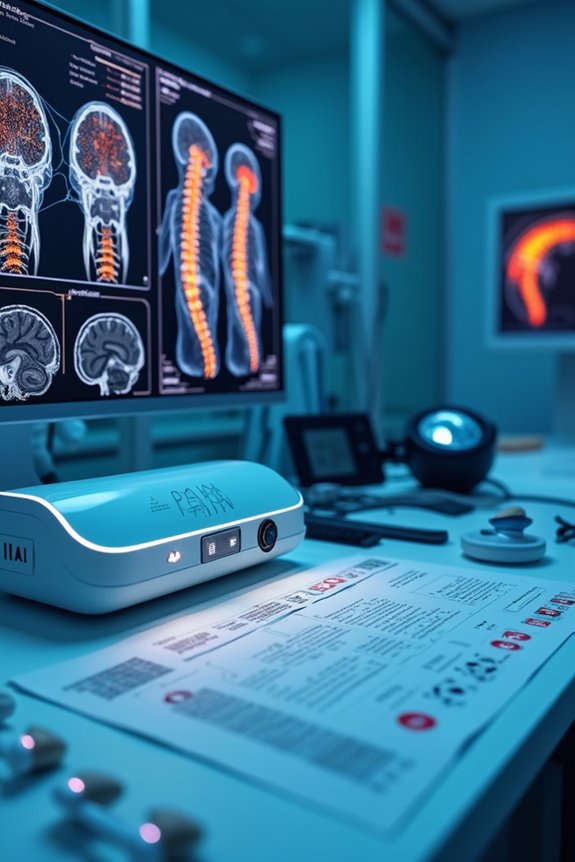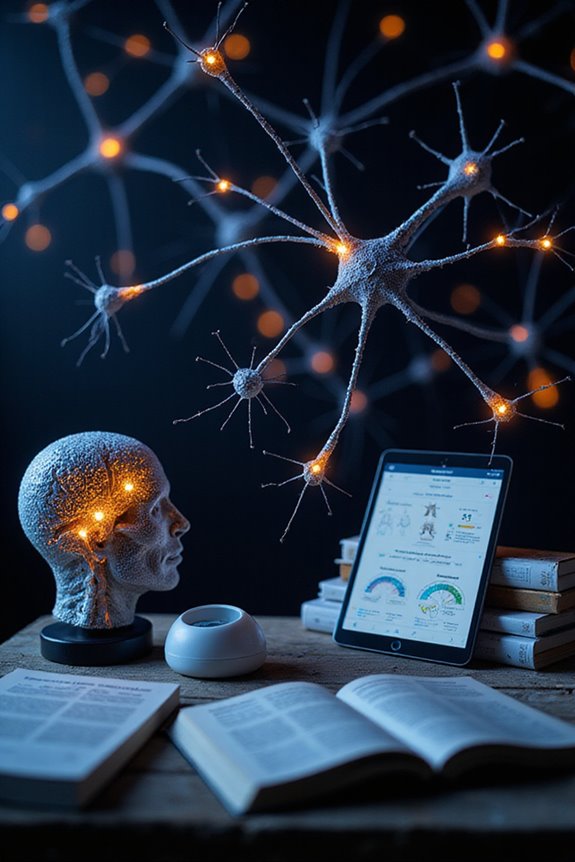Artificial Intelligence considerably enhances pain diagnosis through improved accuracy and personalized treatment strategies. AI analyzes unstructured clinical notes, integrates diverse patient data, and employs advanced algorithms like Support Vector Machines, achieving up to 88% agreement with clinical tools on pain quantification. This technology reduces misdiagnosis risks, supports clinician collaboration, and enables real-time adjustments to care. By utilizing multimodal data, AI fosters tailored interventions for better patient outcomes. Further insights reveal additional benefits and implications of AI in pain management.
Key Takeaways
- AI enhances diagnostic accuracy in pain management by analyzing unstructured clinical notes and integrating patient data.
- Advanced algorithms like Support Vector Machines and Random Forests accurately identify sources of pain.
- AI utilizes facial analysis and physiological data to quantify pain levels effectively.
- Machine learning predicts acute and chronic pain trends, optimizing treatment responses for individual patients.
- Collaborative efforts in AI tool development ensure alignment with clinical needs and enhance patient care outcomes.
The Role of AI in Enhancing Diagnostic Accuracy
AI has emerged as a transformative force in enhancing diagnostic accuracy within pain management. By leveraging AI algorithms, healthcare providers can analyze unstructured clinical notes from electronic medical records, improving automated pain assessment.
Key contributions include:
- Integration of patient demographics, symptomatology, and test outcomes into streamlined diagnostic workflows.
- Use of advanced algorithms such as Support Vector Machines and Random Forests for accurate pain source identification.
- Application of physiological data, like Electrodermal Activity signals, achieving up to 77.66% accuracy in recognizing moderate to severe pain.
Furthermore, AI’s ability to synthesize multi-source clinical data reduces misdiagnosis risks, promoting collaboration among specialists in neurology and musculoskeletal disorders. This integration enhances the precision of diagnosing various pain sources, ultimately benefiting patient care.
Innovative Applications of AI in Pain Assessment

The integration of artificial intelligence has opened new avenues for innovative applications in pain assessment, building on the advancements in diagnostic accuracy.
- AI Applications in Facial Analysis: Utilizing computer vision, AI analyzes facial expressions to objectively quantify pain, achieving up to 88% agreement with established clinical tools.
- Linguistic Assessment: Natural language processing (NLP) techniques classify patient verbal reports, enhancing pain characterization beyond physical signs.
- Sensor Integration: Wearable devices measure physiological signals, allowing real-time pain quantification through multimodal approaches.
- Predictive Modeling: Machine learning algorithms predict acute and chronic pain, identifying trends in patient-specific data.
These innovative applications collectively facilitate more accurate pain assessments, improving patient care and outcomes in various clinical settings.
Personalizing Pain Management Through AI

Personalized pain management has emerged as a crucial focus area in the healthcare sector, leveraging advanced technologies to cater to individual patient needs.
- AI-Driven Interventions: AI identifies pain subtypes, enhancing patient stratification and enabling tailored interventions.
- Personalized Analytics: Predictive modeling integrates multidimensional data, forecasting treatment responses and minimizing adverse effects.
- Real-Time Adjustments: Smart monitoring systems continuously track biomarkers, allowing for adaptive therapies that respond to fluctuating pain levels.
- Holistic Approaches: AI facilitates engagement strategies, supporting individualized care that considers psychosocial factors.
- Data Integration: Extensive data processes enhance diagnostic objectivity and optimize therapeutic precision, ultimately improving patient outcomes and quality of life.
These advancements represent a significant shift toward more effective, personalized pain management solutions.
Technical Performance of AI Models in Pain Diagnosis

Advancements in personalized pain management through artificial intelligence have set the stage for examining the technical performance of AI models in pain diagnosis.
- Accuracy: Support Vector Machine (SVM) algorithms reached a recognition accuracy of 77.66% for distinguishing pain using electrodermal activity data.
- Model Types: Common models include random forests and deep learning, which excel with larger medical imaging datasets.
- Data Quality: Accuracy is heavily influenced by data quality, cohort size, and the complexity of pain conditions.
- Sample Size: Cohorts in AI pain research vary considerably, with typical sizes around 100, impacting generalizability.
- Model Interpretability: Ensuring transparency in algorithms is critical for clinical trust and effective integration into healthcare workflows.
These elements collectively highlight the evolving landscape of AI in pain diagnosis.
Challenges in Implementing AI for Pain Assessment

Implementing AI for pain assessment presents various challenges that can impede its effectiveness in clinical settings.
- Data Representation: Pain is subjective, complicating objective measurements and AI generalization due to individual variability.
- Model Transparency: AI models often function as “black boxes,” limiting clinician understanding of outputs, which affects trust and integration.
- Clinician Training: Effective use of AI tools requires extensive training to navigate their limitations and applications.
- Patient Consent: Collecting sensitive data raises concerns about consent and ethical implications.
- Workflow Integration: Poorly designed systems may disrupt clinical workflows, leading to alert fatigue.
- Demographic Disparities: Underrepresented groups in data can exacerbate biases in pain diagnosis.
- Feedback Mechanisms: Continuous updates are essential to enhance model performance and address emerging pain conditions.
Ethical Considerations in AI Pain Diagnosis
How can ethical considerations shape the integration of AI in pain diagnosis?
Ethical frameworks guide the integration of AI to guarantee patient autonomy and informed consent.
- Patients must have the right to opt out of AI involvement in their care, promoting autonomy.
- Clear communication about AI’s role is essential to uphold informed consent.
- Data privacy is critical, necessitating compliance with regulations like HIPAA and GDPR to protect sensitive information.
- Algorithmic bias can lead to unfair treatment; therefore, AI must be developed with unbiased datasets to guarantee equity.
- Transparency issues must be addressed, allowing both clinicians and patients to understand AI recommendations.
- Accountability measures should be defined to clarify responsibility for diagnostic errors, ensuring trust in AI systems.
Future Perspectives on AI in Pain Management
The integration of artificial intelligence (AI) in pain management is poised to revolutionize the approach to diagnosis and treatment.
Neurotechnology Advancements
- AI facilitates real-time adjustments in neuromodulation therapies, enhancing patient outcomes.
- Continuous feedback loops optimize stimulation parameters for sustained relief.
Predictive Algorithms
- Advanced algorithms can predict pain risk and symptom progression, guiding early interventions.
- Machine learning improves patient selection for therapies like spinal cord stimulation, increasing efficacy.
- Personalized treatment plans leverage genetic and lifestyle data, fostering adherence and clinical success.
Patient Engagement
- AI tools, including chatbots, empower patients through education and support, encouraging active participation in care.
- Remote monitoring allows timely interventions, enhancing access to pain management resources.
Collectively, these advancements promise a more effective, engaging approach to managing pain.
The Importance of Multimodal Data in AI Systems
Multimodal data integration plays a critical role in enhancing AI systems for pain diagnosis, as it allows for a more thorough understanding of patient experiences.
- Diverse Data Forms: Multimodal AI incorporates various inputs—facial gestures, speech cues, images, and sensor data—to create a unified model for pain detection.
- Improved Accuracy: This integration achieves up to 92% accuracy in detecting pain levels, surpassing traditional methods.
- Real-Time Monitoring: By synchronizing data from wearables and clinical records, AI can dynamically track pain responses.
- Enhanced Personalization: Patient-specific time-series data allows for tailored treatment plans that adapt to individual experiences.
Collaborating for Better Pain Management Solutions
Collaborative efforts in pain management are increasingly vital as healthcare systems endeavor to integrate advanced AI technologies into clinical practices. Interdisciplinary collaboration among clinicians, data scientists, and engineers is essential for developing AI-driven pain management tools. This shared expertise enables the effective validation and implementation of solutions tailored to clinical workflows.
Key aspects include:
- Continuous communication guarantees that AI algorithms align with clinical needs.
- Collaborative networks facilitate the exchange of multimodal datasets for refining predictive models.
- AI enhances patient engagement by providing personalized education and support, fostering active participation in care decisions.
Such integration of AI not only optimizes pain diagnosis but also improves overall patient experiences, guaranteeing a holistic approach to pain management.
Frequently Asked Questions
How Does AI Impact Patient Privacy in Pain Diagnosis?
Patient privacy in healthcare faces unprecedented challenges as AI’s data security measures falter. Without robust patient consent protocols, the potential for re-identification looms, raising concerns about confidentiality and trust in the evolving landscape of medical technology.
What Types of Data Are Most Effective for AI Pain Models?
Effective AI pain models leverage diverse data types, including patient feedback, sensor data from wearable technology, medical history, imaging results, and behavioral patterns, fostering a holistic understanding of pain that resonates with individuals’ experiences and needs.
Are There Any Biases in AI Pain Assessment Algorithms?
Algorithmic bias breeds barriers, betraying the belief in equitable healthcare. Insufficient data representation perpetuates disparities, skewing pain assessments. Acknowledging these flaws fosters a future where every individual’s pain is recognized, promoting genuine belonging and understanding.
How Can Patients Participate in Ai-Driven Pain Management?
Patients can actively engage in AI-driven pain management by providing patient feedback and participating in symptom tracking. This involvement fosters a collaborative environment, enhancing personalized care and empowering individuals to manage their pain more effectively.
What Are the Costs Associated With Implementing AI in Pain Diagnosis?
In the labyrinth of healthcare innovation, implementation expenses and technology investments intertwine, creating a complex tapestry. Initial costs soar with hardware and model development, while ongoing training and compliance add layers of financial intricacy for organizations.





